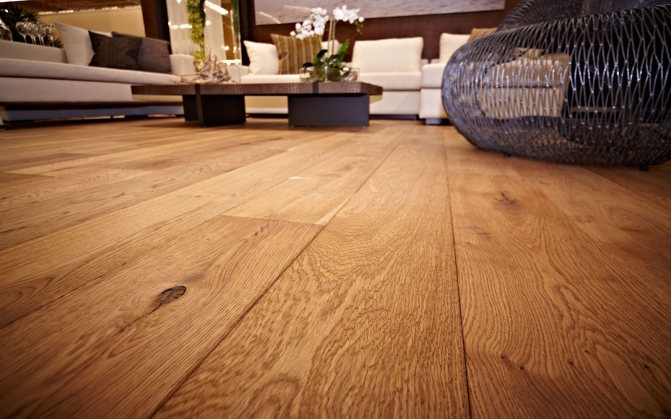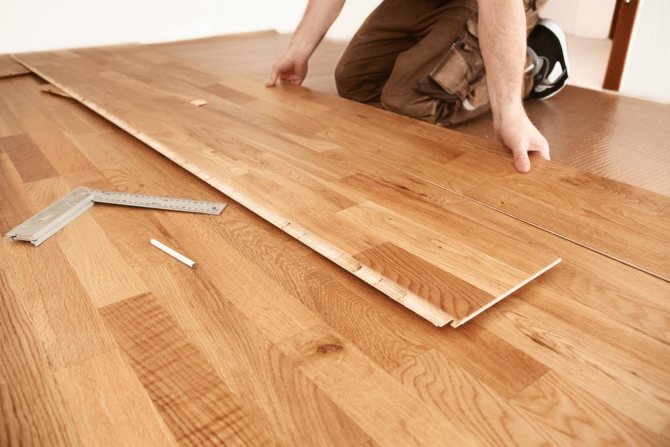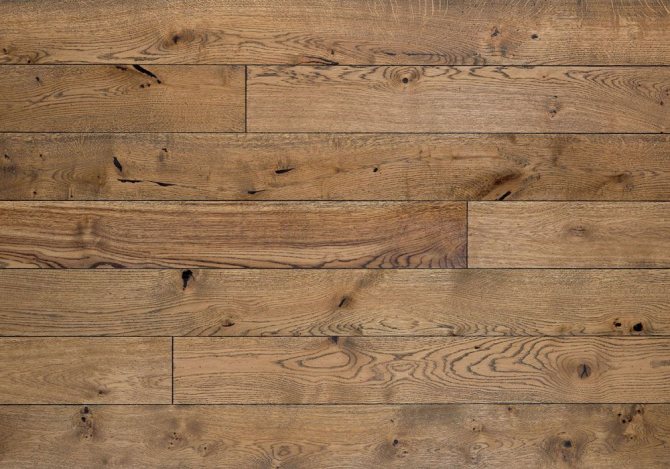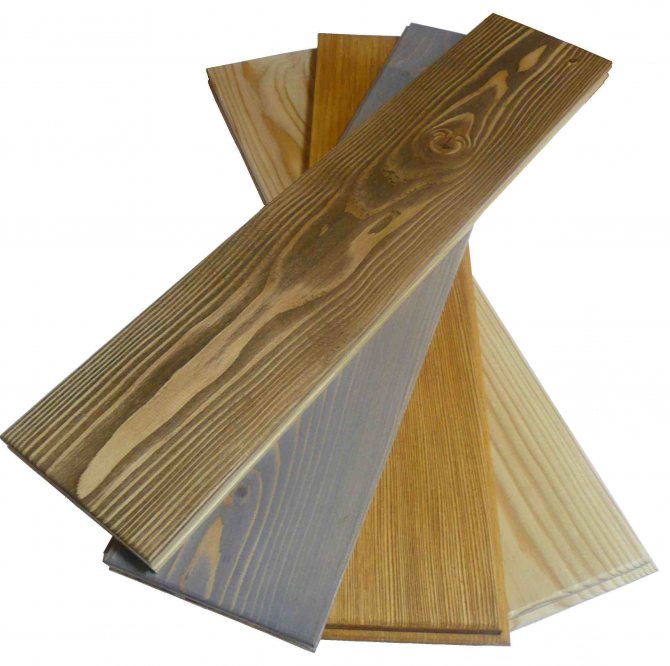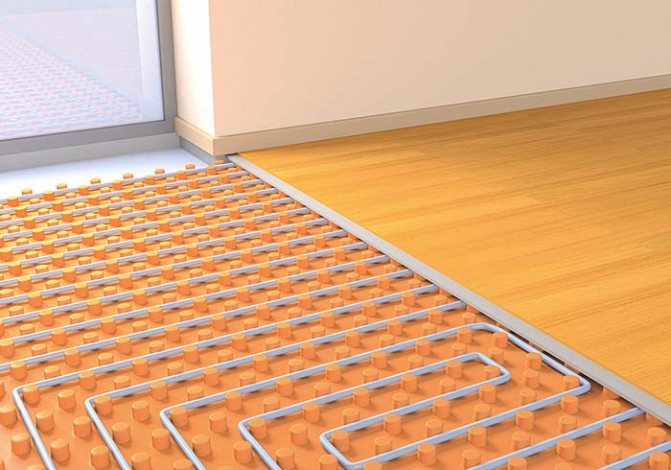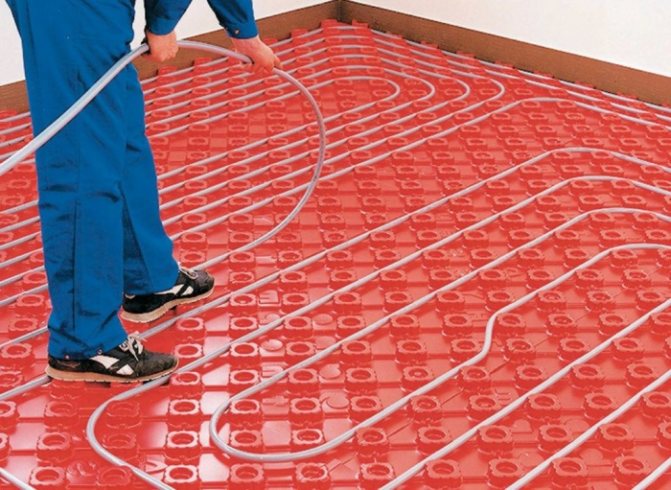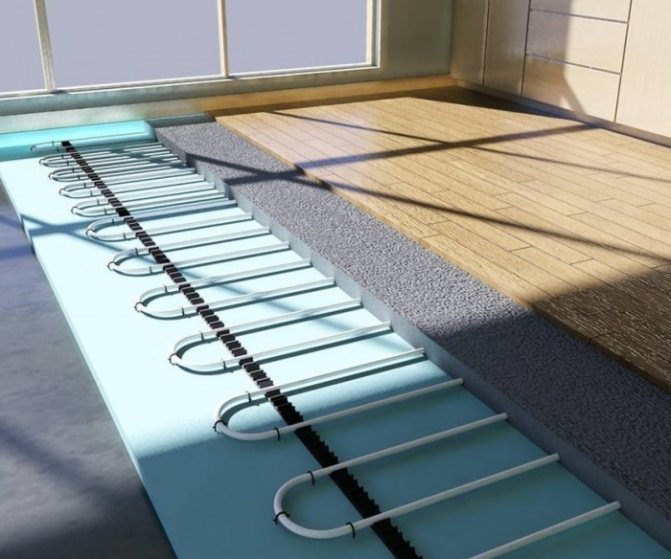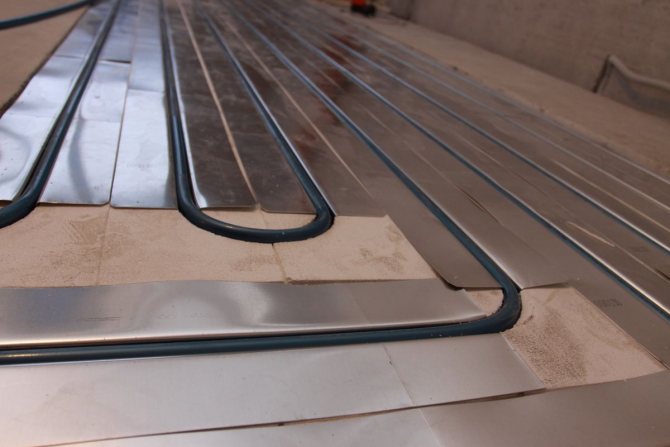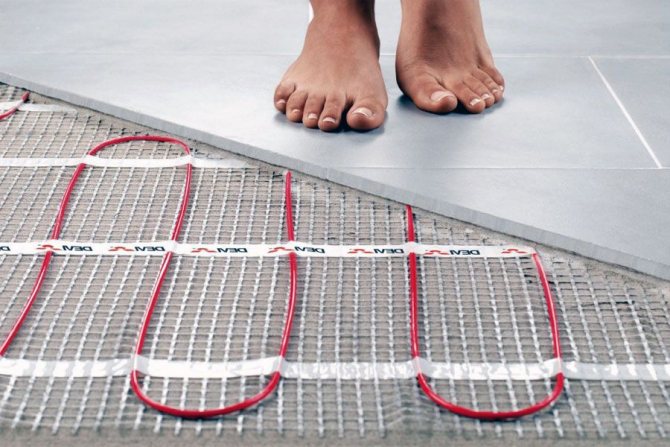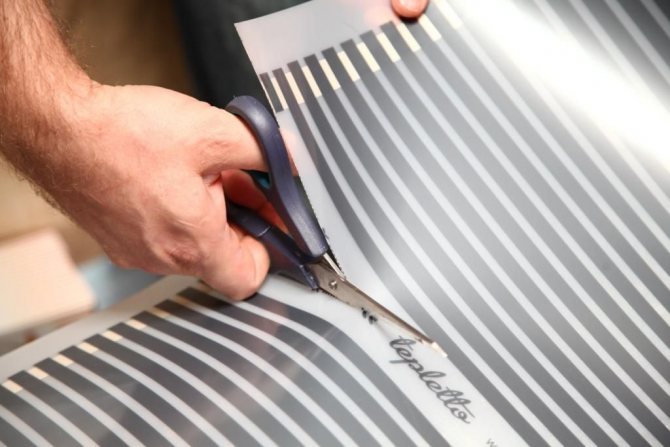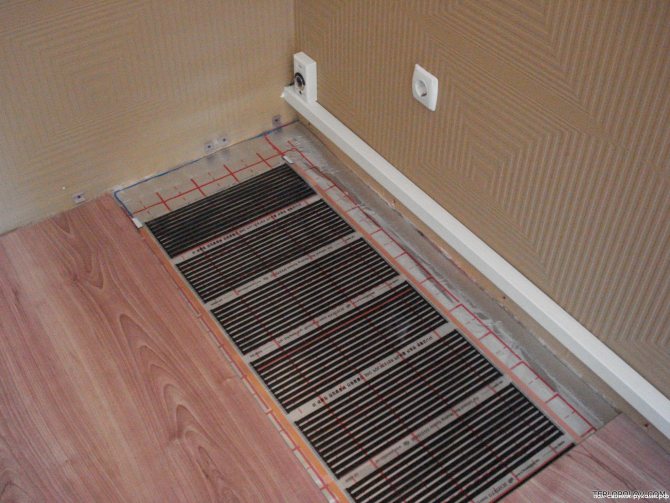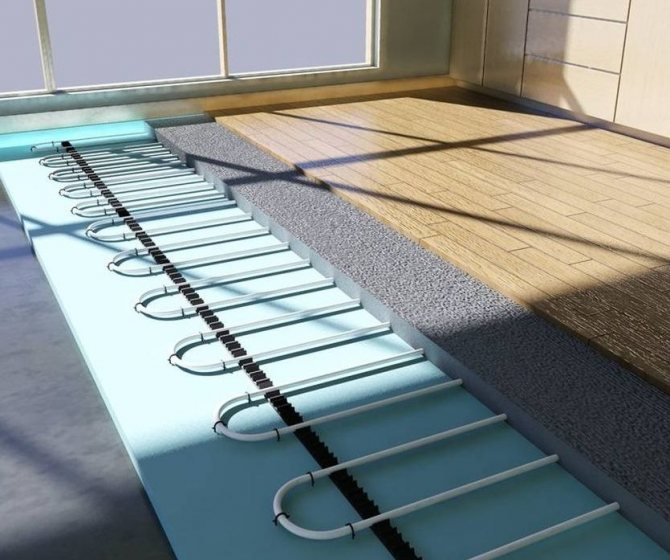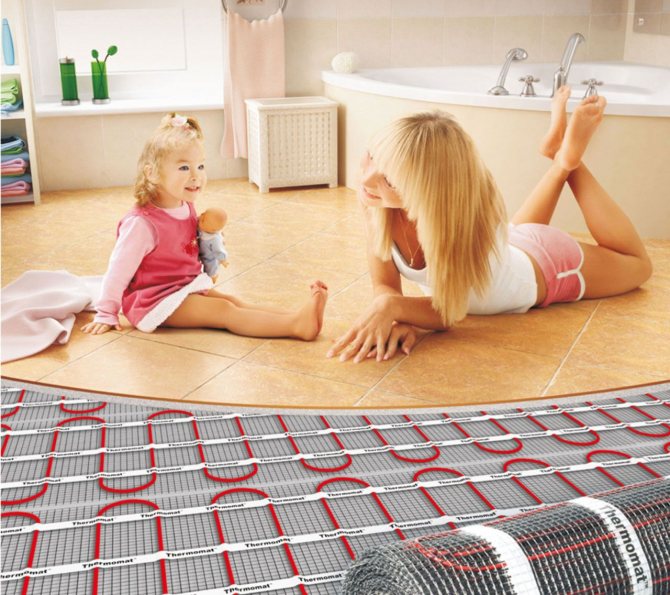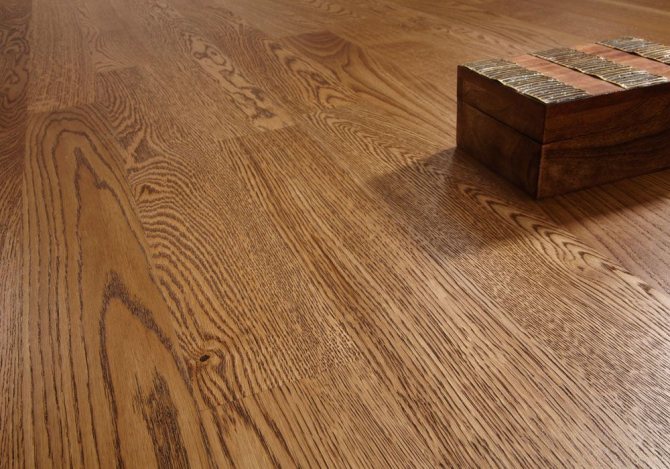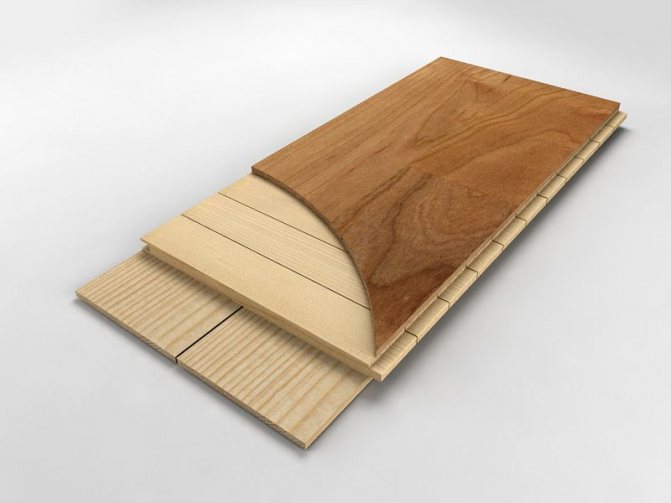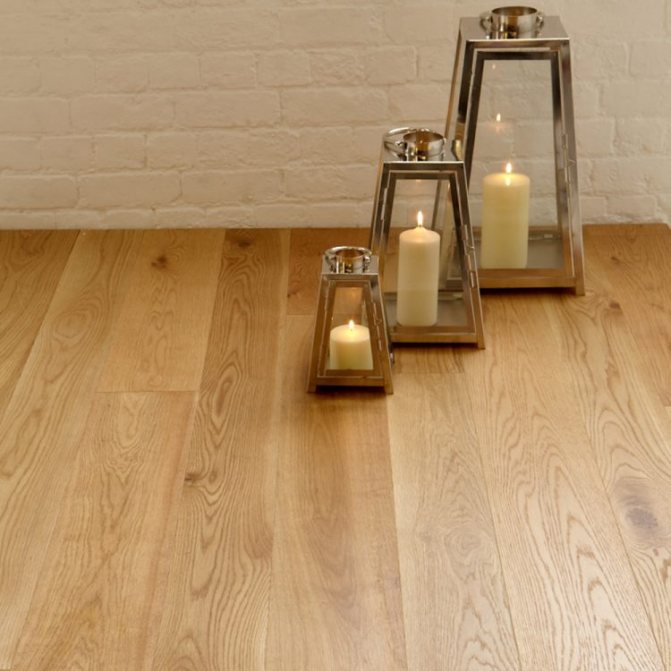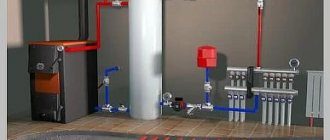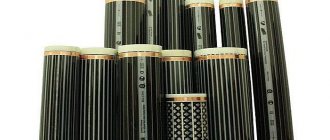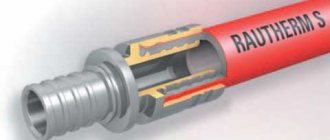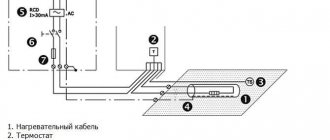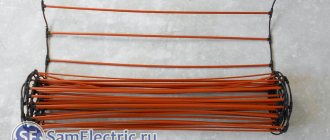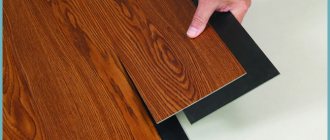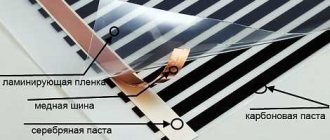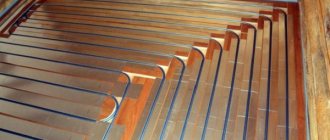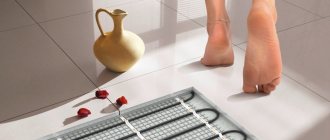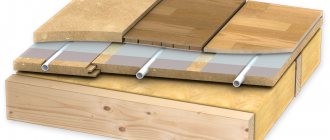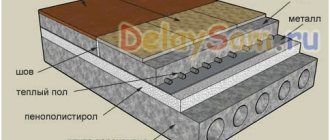Parquet flooring is a beautiful and comfortable floor covering made of natural wood. There are two main options for such a floor - from solid blocks or a three-layer parquet board, in which several types of wood are usually combined. Many people are interested in the question of whether it is possible to put the "warm floor" system under parquet or parquet board. The most widespread opinion is that parquet and "warm floor" are incompatible concepts. Is it so? And if so, why? And if you really want to combine them, maybe you can still? What system of "warm floor" is best combined with parquet planks or planks - water, electric, infrared? Let's try to understand all these issues in detail.
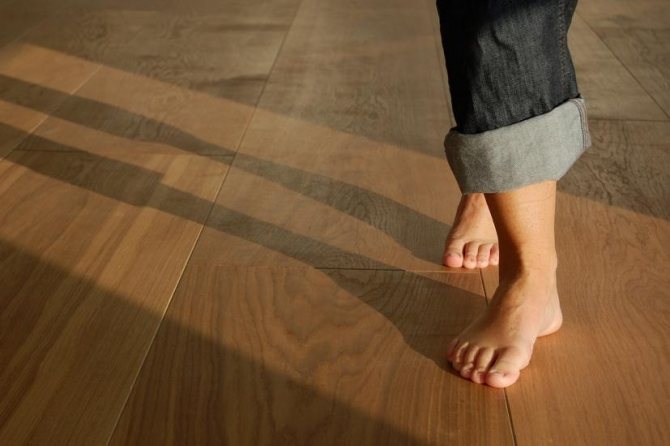
Parquet board on a warm floor
Types of suitable warm floors for parquet boards
Considering that the heating system gives an additional thermal load on the coating (in particular, parquet board), it is important to choose the most suitable type of warm floor. At the moment, there are 3 types of warm floors - infrared, electric and water - in order to choose the best option - we will consider each type separately
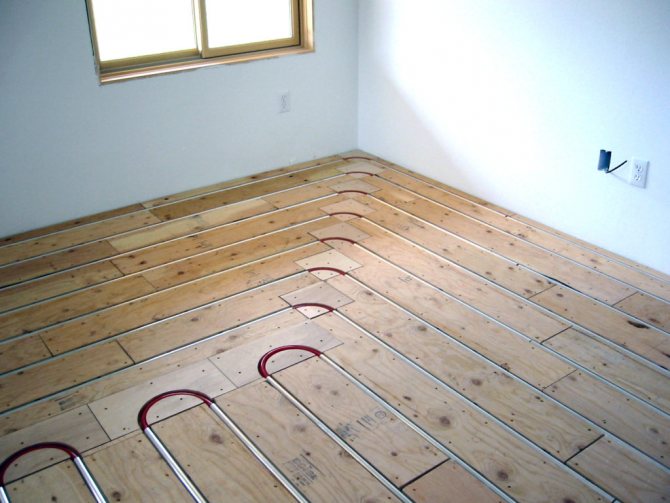

Infrared systems
Infrared heating systems consist of graphite elements embedded in a polymer film. When heated, the elements that make up the composition emit thermal energy in the infrared range, which is transferred to the parquet flooring. When using an infrared heating element in combination with a warm floor, it is undesirable to heat the coating over 28 degrees.
Electrical systems
Electric heating systems operate using heat cables. This heating system belongs to the most budgetary ones; the conductors, in combination with a wooden covering, increase the risk of fire. In this regard, a parquet board for a warm floor of this type is not recommended for use.
Water systems
Water heating systems consist of plastic pipes, inside of which there is water that is heated to the required temperature. This system evenly heats the floor and is completely safe, although the possibility of leaks is not excluded. That is why parquet board for warm water floors is the ideal option.
What is a parquet board and its composition
Classic parquet made of solid wood is categorically not combined with a warm floor, since due to its large thickness it conducts heat worse (this reduces the efficiency of the system), and also quickly dries and cracks under the influence of heating.
An affordable alternative to block parquet is parquet board, which consists of three layers connected with glue: the lower one - lamellas made of durable and inexpensive wood, usually softwood;
- middle - laths or planks of coniferous wood, oak, birch or beech laid across the lamellas (second-grade material is used to reduce the cost);
- top - high-quality veneer made of dense wood of valuable species.
The front part of the parquet board, designed for use in combination with a warm floor, must be resistant to temperature influences. Such materials include wood:
- olives;
- walnut;
- wenge;
- ash;
- oak;
- mahogany.
Important! Maple and beech wood quickly loses its attractiveness when exposed to temperature. Parquet boards made from these types of wood are not recommended for warm floors.
In order to reduce the cost of production, manufacturers offer budget solutions, replacing the natural wood of the lower layers of parquet with wood-containing materials. In this case, the back of the board is made of waterproof chipboard, and the middle layer is made of MDF.
It should be borne in mind that in most cases the parquet board on the market contains formaldehyde hazardous to health, which actively evaporates when heated. When choosing a floor covering, you should give preference to products marked by the manufacturer for use in conjunction with a warm floor. This means the absence or minimum content of harmful substances and resistance to temperature influences.
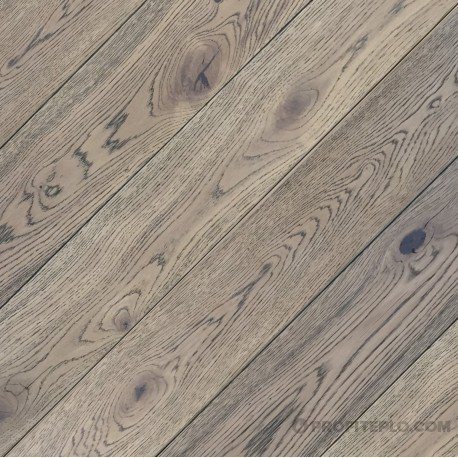

Is it possible to put parquet or parquet board on the warm floor
We have explained why parquet, parquet board and solid floor board are not the most suitable types of flooring for a warm floor. Suitable - ceramic and stone tiles, acceptable - laminate, non-insulated linoleum and low-pile carpet. So after all, is it possible to put parquet or parquet board on the warm floor? We answer: it is impossible. But if you really want to, you can. You just need to understand that, firstly, this will negatively affect the efficiency of the heating system. Secondly, such a solution imposes a number of restrictions both on the functioning of the heating system and on the selection and installation of wooden floors. More about this:
Features of the device of a warm floor under a natural wood covering
To prevent cracks from appearing in the parquet or parquet board during the heating season, the floor heating should not be strong. If we remember about formaldehyde, the warm floor under the parquet board should not be heated above 26 ºC. But that's not all. Manufacturers of solid parquet and parquet boards claim that in order to avoid deformation of the wood and to maintain its service life, the difference between the temperature of the coating and the indoor air should not exceed 2 ºC. If you adhere to the +18 ºC norm for residential premises, the floor should not be heated above 20 ºC. At this temperature, the floors will not feel cold, you can walk on them barefoot. But the heat generated by them is not enough to warm the room during the cold season. Of course, if we are talking about Central Russia, not Sochi. No, in a super insulated energy efficient passivehouse with forced recuperation ventilation and such a small amount of thermal energy will be enough for heating, but how many such buildings have we built? Therefore, in an ordinary house in a room with natural wood floors, the main heating devices should be radiators, and underfloor heating only complements them, only slightly heating the parquet.
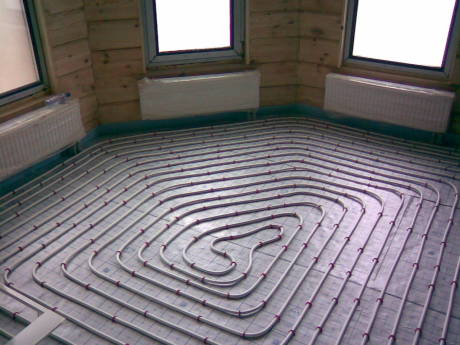

A standard mixing module for warm water floors will not be able to provide accurate and smooth temperature control at such low values and in a narrow range. You will need additional equipment: a floor temperature sensor (floor temperature, not room air) and a control valve servo.
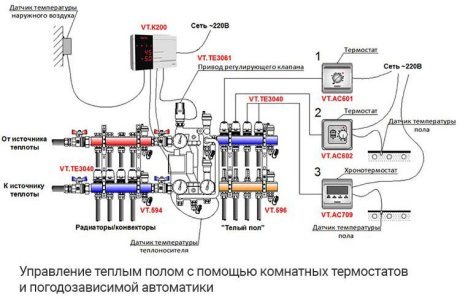

And do not forget that wood does not transmit heat well from heating pipes, so the thickness of the heat-insulating layer must be increased from below so as not to waste energy and money in vain.
Features of the selection of parquet and plank flooring for underfloor heating
For a heated floor, you should select parquet and parquet boards made from the most stable types of wood. Oak, ash and walnut work best. The hornbeam behaves well. Exotic breeds other than teak and iroko are best avoided. Beech and maple are categorically not suitable, they are most susceptible to temperature and humidity expansion. It is advisable to use a larch floorboard.
You should choose a parquet board of average thickness - 13-17 mm. A thin 10mm one can warp, and a thick one will not let heat pass through well.It is better to choose parquet with a thickness of 16-18 mm, and a floorboard - 25 mm.


Features of installation of parquet flooring on a warm floor
If the above-mentioned temperature regime of floor heating is maintained, any type of wooden floor can be used as a covering: massive parquet and parquet board, glued multilayer parquet board, massive floor board. However, one should take into account the technology of installation of the coating:
The multi-layer parquet board is laid in a "floating" manner on the substrate without fixing to the base. There will be no problems with the accurate installation of such a floor, the recommended substrate thickness is 2-3 mm.
Solid parquet on a concrete screed should be laid on plywood, which, in turn, must be glued and fixed with dowels to the base. When laying the heating pipes, it is necessary to make a very accurate diagram of their location and, while drilling the holes in the screed for the dowels, take great care not to damage the pipe.
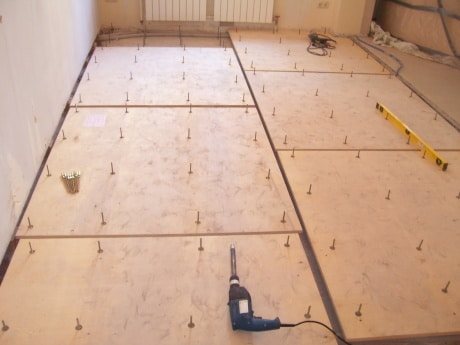

Heating system installation requirements
It is important to ensure that the bottom layer of the finishing coat does not heat up to 40 degrees. For the installation of underfloor heating according to the instructions, the following features should be taken into account:
- Laying of parquet panels on the heating system should be carried out "floating" method. This will compensate for thermal expansion and contraction.
- It is better if plywood is laid under the parquet boards. It must be fixed to the base with self-tapping screws. The sheets should be fastened taking into account the communication networks.
- Before laying the finished floor, a heating system that has already been installed in the base must be checked for faults. During testing, the optimal temperature regime is established.
- It is better to entrust the installation of a parquet board to an additional heating system to professionals.
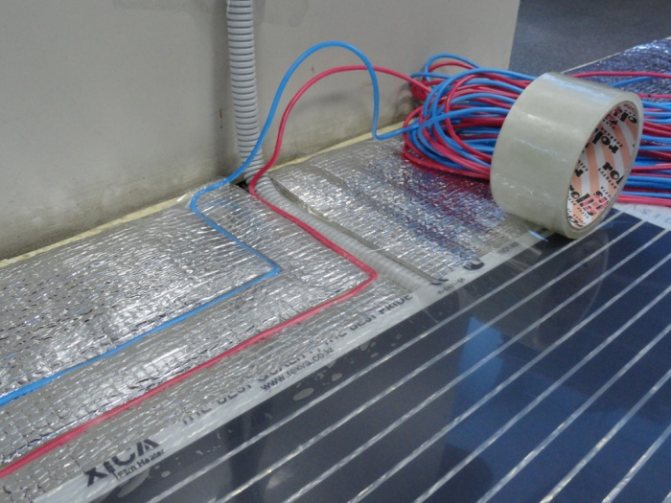

Taking into account these features of the installation of a parquet board, the floor covering will serve for quite a long time.
If you choose the right flooring, as well as follow the recommendations of experienced builders when installing a warm floor, you will be able to lay an excellent floor.
Choice of underfloor heating technology
Before laying a warm floor, you need to decide on its type. It is best to use an electric underfloor heating under the parquet, since in this case there is no danger of damaging the parquet board. When using water heating, in the event of emergencies, such as water leaks, the parquet floor can swell and deteriorate.
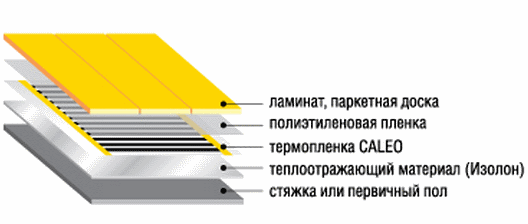

Diagram of the device for underfloor heating under parquet.
The work itself on laying the parquet board is quite lengthy, therefore, in case of a violation in the heating system, this coating will have to be removed, which is quite problematic.
It is also of great importance that the parquet board can be attributed to good insulation and if it is installed correctly, floor insulation may not be required. But still, if you install a warm floor under the parquet, then you need to remember that there must be a fireproof covering under it.
Stages of installing a warm electric floor
The most modern way to insulate a parquet board is with an electric cable. But in this case, there is 1 drawback - fire safety
Because of this, it is important to properly organize the insulation. At the first stage of work, the base is cleaned, all irregularities and debris are removed
For leveling, you can use a putty. Then a layer of waterproofing compound is applied. Support beams are installed on the base of the floor. They are made at a distance of 50-60 cm from each other. The surface between them is filled with waterproofing materials. Penofol or other sheet foam materials can be used.
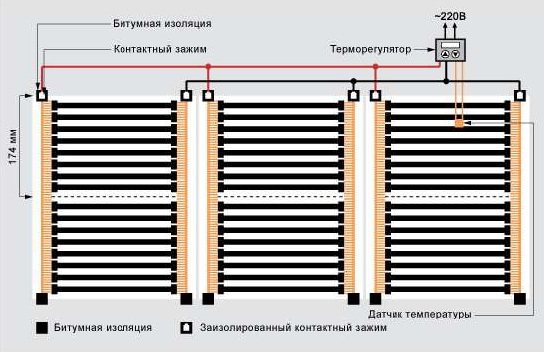

Installation diagram of an infrared film underfloor heating under a parquet board.
Roll materials such as mineral wool, for example, are also widely used.They need to be laid in strips. Fasten with special glue or make them overlap at least 10 cm. After that, you need to make a finishing floor. For this you need a parquet board. A galvanized mesh is placed on top. The electric cable itself, in order to insulate the parquet board, is placed next to the beams at a distance of at least 1 cm from them. In the beams, cuts are made not for the entire thickness of about 3 cm wide, foil is laid, and an electric cable is laid on it. The cable is secured with mounting tape. A layer of non-combustible material will need to be made over the cable again. After that, it is necessary to organize the finishing floor. Warm floor under the board is ready. It is recommended to use plywood or wood-fiber materials (fiberboard) as a basis for a parquet board, which are fastened with self-tapping screws. In this case, a sheet of plywood 50 x 50 cm must be fixed in 8 places.
The main disadvantages of parquet insulation
As already mentioned, it is not necessary to insulate a parquet board at all. Before doing this, you need to know the possible negative consequences during the work. Firstly, the parquet itself does not allow cold air to pass through, thus, in the presence of a layer of insulation, the work of the parquet board for heating the room deteriorates. The parquet flooring in the apartment does not need additional thermal insulation. Secondly, in the presence of a heating layer, the parquet can dry out and crack. Its appearance changes and aesthetics decreases. All this in the end will require major repairs from the tenants, or you will have to periodically repair cracks, putty the floor with your own hands.
The underfloor heating system is more suitable for tiles than planks. Therefore, it is advisable to insulate the floor in the bathroom, on the loggia, toilet. Thirdly, the technical side of the process is also of great importance. In addition to the possibility of emergency situations, there is a possibility of damage to the insulation system itself: pipes or electrical wires. The thing is that the best option for insulating parquet is using plywood, which is attached to the screed with self-tapping screws. In this case, there is a possibility of damage to the wires or pipes, and it will be very difficult to find this area. An alternative to perket is laminate.
Installation instructions for cable heating under a parquet board
An electric underfloor heating can act as an independent source of heat, or be used as an additional heating.
System installation technology:
Step 1... On a flat floor (the surface quality in this case is of great importance, since cable bends provoke its breakdown), hydro and thermal insulation (polyethylene film and expanded polystyrene) are laid. A damper tape is fixed around the perimeter of the room (as in the previous paragraph).
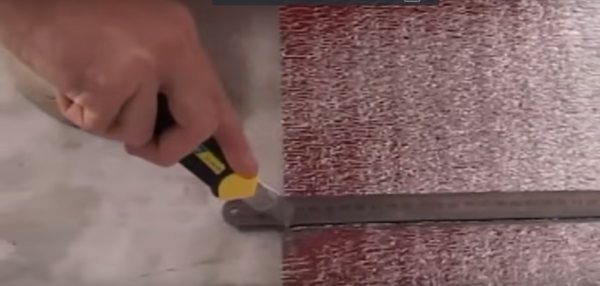

We install thermal insulation
Step 2... A reinforcing mesh is laid on the insulation.
Step 3... A thermostat is attached to the wall (at a height of 30-50 cm from the floor). A groove for the cable runs down from it.
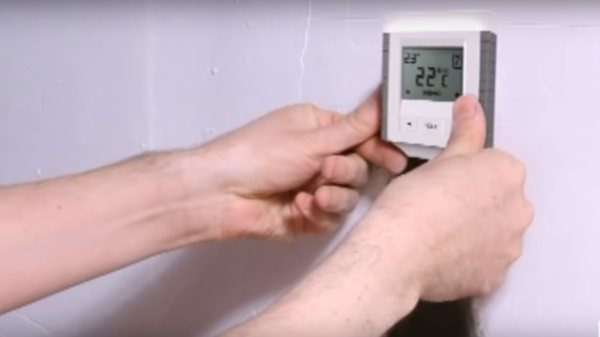

We fix the thermostat
Step 4... A heating cable can be used as the main element of the heating system, but it is more convenient to lay mats, which are fiberglass cloth with a cable fixed on it with a certain pitch. If, nevertheless, a separate cable is chosen, its installation can be carried out on a special tape fixed in the tie with self-tapping screws, but in our case it is attached to the reinforcing mesh using clips.
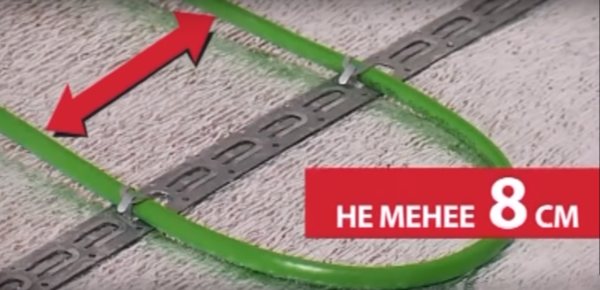

We lay the cable
The table will help you to correctly calculate the heating system:


Heating system calculation table
Step 5... A thermostat is placed in the corrugated pipe between the heating lines at a distance of 50 cm from the wall.
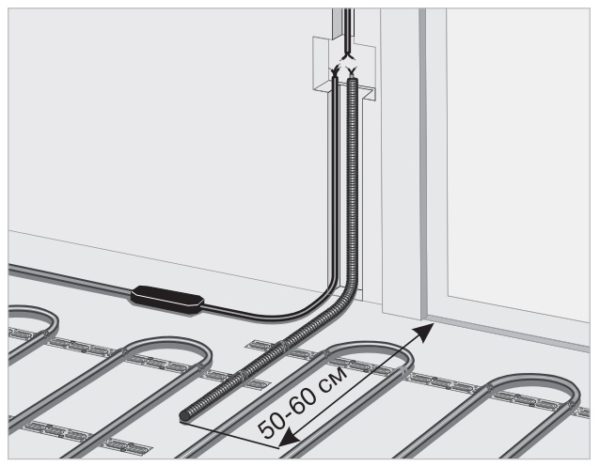

At a distance of 50 cm from the wall, we lay the thermostat
Step 6... The warm floor is connected to the mains, the structure is tested.
Step 7... If the system functions normally, a 5-6 cm thick concrete screed is poured and leveled.
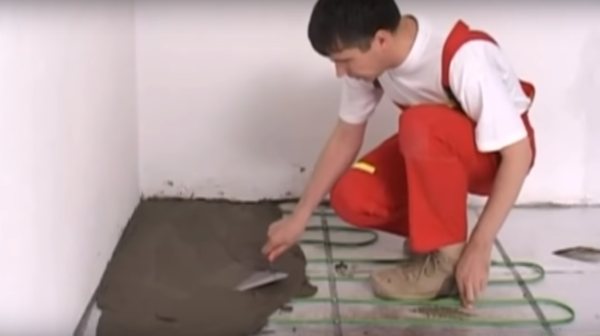

Fill the floor with concrete screed
The result is a pie like this:
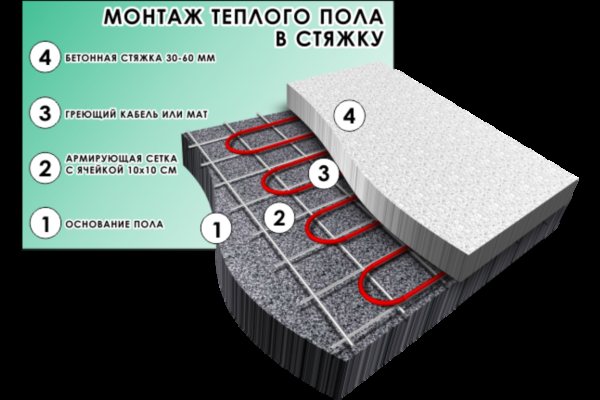

Underfloor heating installation
Step 8... After the concrete has hardened (after 28 days), a parquet topcoat can be installed (on a foam, cork or plywood backing). Again, use the floating method.
The "warm floor + parquet board" system has the right to be used. With the correct design, an optimal microclimate will be created in the room.
Features of heating such a floor
To summarize, there is only one feature - caution. The maximum water temperature should not exceed 50 degrees
But the lower surface of the tree should not heat up by more than 40 degrees.
The above parameters are very easily controlled by the equipment that is part of the heated floor, and, on the contrary, in a situation of heating with electricity, it is very difficult to adhere to them. Therefore, parquet flooring is better suited for a water-based floor heating system.
Experts studying parquet flooring have long noticed that under more or less traditional conditions of our climate in winter, gaps between parquet floorboards will be clearly visible, which will disappear in warm summer. This is also the result of temperature fluctuations, from which the humidity readings are subject to fluctuations.
If you want to minimize gaps, it is worth laying planks with a minimum width.
Answering the question about the advisability of using parquet for warm water floors, let's say that it is quite possible and even effective. If you adhere to certain rules, everything will turn out in the best way.
Electric underfloor heating and wood flooring
Some readers ask if electric underfloor heating is suitable for parquet and parquet board? The answer is: more likely no than yes. The fact is that a heating cable or film, unlike “brooding” pipes with a liquid heat carrier, heats up too quickly, literally in a matter of seconds. If the wood flooring is laid directly on the heating elements (through an insulating backing), the chances are high that the wood will break down and warp or even crack from the thermal effects. At the same time, electric heating will not cause any noticeable damage to a laminate covering imitating parquet.
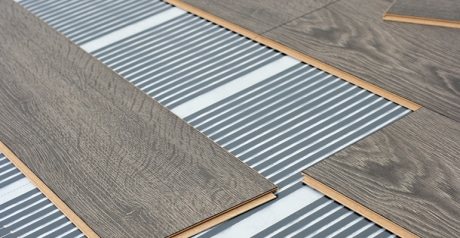

It is better to put a laminate, not a parquet board, which can be deformed, on a rapidly heating film electric warm floor. It is much less sensitive to temperature changes
The only option in which the electric underfloor heating is more or less compatible with a wooden covering is a design in which the heating electric cable is embedded in a concrete screed, extinguishing sharp fluctuations in the heating temperature.
Laying parquet on underfloor heating all pros and cons
Professional builders-finishers still cannot come to a consensus on whether a warm floor under a parquet board is an acceptable option.
Each side has its own compelling pros and cons of laying natural wood flooring on a warm floor.
"Vs"
First, consider the arguments of those who are categorically against the use of parquet boards for underfloor heating.
- Poor thermal conductivity. Due to the fact that natural wood has a low coefficient of thermal conductivity, the transfer of thermal energy from the heating elements to the room air will be significantly difficult. Accordingly, underfloor heating will lose one of their main advantages: higher efficiency compared to wall-mounted radiators. To maintain a comfortable room temperature, you will have to warm up electrical wires or heat transfer fluid to higher temperatures.The economy and efficiency of ultra-modern underfloor heating will eventually become on a par with the "classics" of a century ago - suspended heating radiators. The underlay for the parquet board, which is an integral element in the installation of the floor covering, will only aggravate the situation.
With regular exposure to high temperatures, the tree can deform
The next argument against is related to the performance characteristics of natural wood. Using a parquet board as a conductor of thermal energy can adversely affect its condition. Under the influence of regular temperature changes, even a well-mounted coating can soon acquire an unpresentable look. Dry, creaking floorboards, cracks and deformation of wood, peeling varnish are possible consequences of exposure to high temperatures. For a warm water floor, there is another argument against laying parquet boards on top of it. It's all about the coolant circulating through the plastic pipes. Despite many years of warranties from manufacturers of water floors, there is the potential for water breakthroughs or leaks. As a result of such, even purely hypothetical, accidents, your expensive flooring may become unusable: the fungus and rot that multiply under it will quickly do their job. For more information on using parquet flooring on warm floors, see this video:
However, in spite of everything, a number of experts consider the flooring of a parquet board over underfloor heating quite acceptable. To do this, you should only follow certain rules and recommendations.
- Uniform heating of the entire surface of the floor covering. The ideal option for combining parquet and underfloor heating without conflict is IR heating elements. Infrared underfloor heating under the parquet board ensures the most even heating of all floorboards. As a result, the risk of joint cracking or deformation of the wood is minimized.
- You should not buy parquet boards made of natural maple and beech for flooring on warm floors. Their wood is very sensitive to temperature changes, which causes its deformation and cracking.
- The optimum thickness of the parquet board is 12 mm. Thinner options will become unusable too quickly under the influence of temperature changes, and too thick parquet will create an unnecessary obstacle to heat circulation.
- Along the perimeter of the walls at the level of the flooring, fix the damper tape. It will play the role of a shock absorber during compression-expansion of parquet under the influence of temperature differences. For the same purpose, parquet should be laid in a "floating" version without a rigid bond with the base of the floors.
- Recently, special varieties have appeared on the construction market, combined with floor heating systems. They are individually labeled, as well as recommendations for their mode of operation.
In no case should self-tapping screws and dowel-nails be used: the likelihood of damage to the water pipes poured into the screed or the power cable is too high. For more information on laying parquet on a film floor, see this video:
Having become familiar with the features of parquet flooring and floor heating systems, each owner can independently weigh the pros and cons, choosing the option that suits him the most.
Subtleties of installation
Since wood has a low thermal conductivity, rather thick floorboards will be quite a serious obstacle to the heat coming from the heating elements. It is also necessary to choose the right coating material. The strength of a parquet board depends on the type of wood from which the top layer is made. It is he who accounts for the "heatstroke" that can cause deformation of the strips.
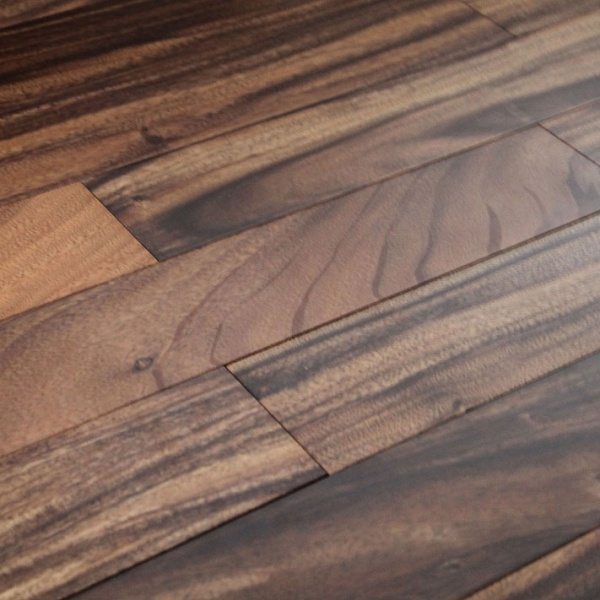

It is best to choose oak or walnut panels for installation on a warm floor.Such wood under the influence of temperature expands and contracts the least. If you use maple or beech, warping of the boards under the influence of heat coming from the warm floor is inevitable.
When finishing the floor with a parquet board, the following points are also taken into account:
- Board thickness. Considering that wood has a low thermal conductivity, you should not mount boards that are too thick. Heat from heating elements will not penetrate into the room.
- Laying method. The tree expands linearly not only during heating, but also in the event of an increase in humidity in the room. To avoid deformation of the floor, the panels should be laid using the “floating” method.
- The type of heating elements used in the underfloor heating system. To exclude wood fire, it is worth choosing the safest heating system.
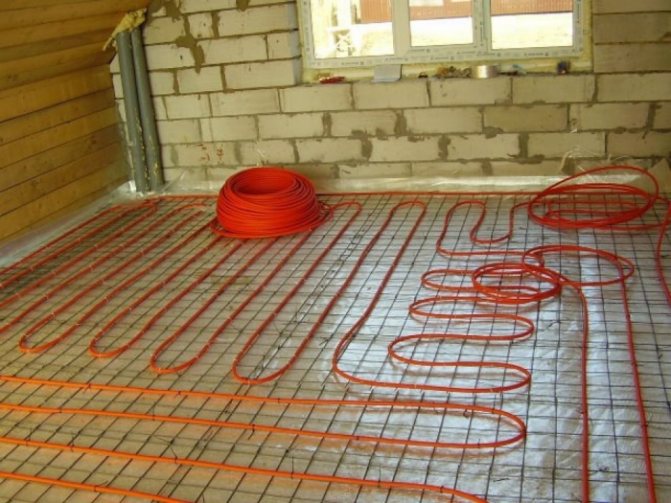

Such features of installing a warm floor under a parquet board are taken into account even before the choice of materials.
The closest covering to parquet is parquet board. She is chosen as laying on a warm floor quite often. The method of assembling such a coating is quite simple, and resembles the method of installing a laminate - panels are laid on the substrate, connected to each other by a lock connection. However, not every manufacturer of parquet boards recommends mounting it on a heated base.
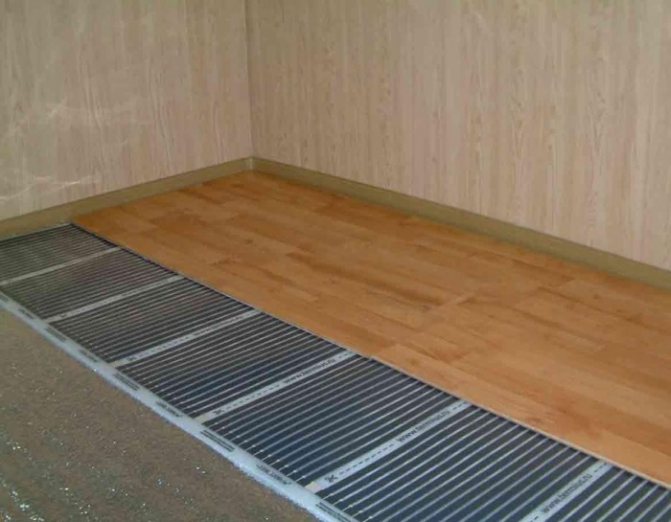

When deciding to choose this particular material for laying on a warm floor, it should be borne in mind that the temperature at the surface should not exceed 26 degrees. In this case, heating should be uniform over the entire surface. However, even in this case, there is a risk that the wood will dry out. It is pointless to use beech or maple for such purposes.
The parquet floor is natural and as safe as possible. It serves as a natural thermal insulation of premises, incapable of harming health. Such features of the installation of a warm floor must be taken into account before deciding to combine a parquet board and an additional heating system.
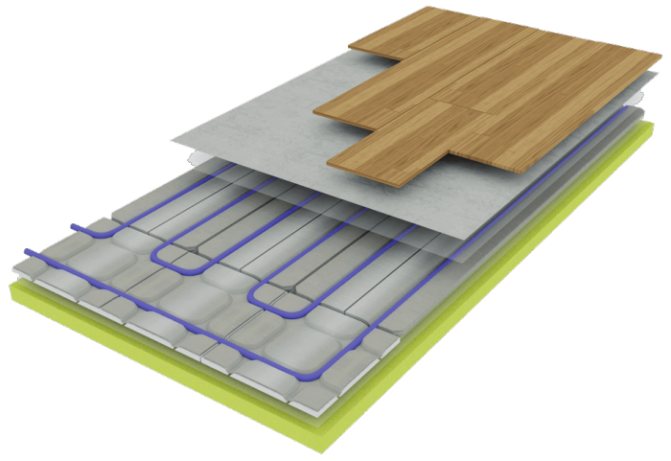

Installation of a water floor
A water floor is a good solution and is often made when a wooden floor needs to be laid. Thanks to this, the room is heated without problems, and an additional heating system is not required. Advantages of systems of this type:
- the minimum amount of electricity is consumed;
- they are safe and environmentally friendly;
- the base heats up evenly.
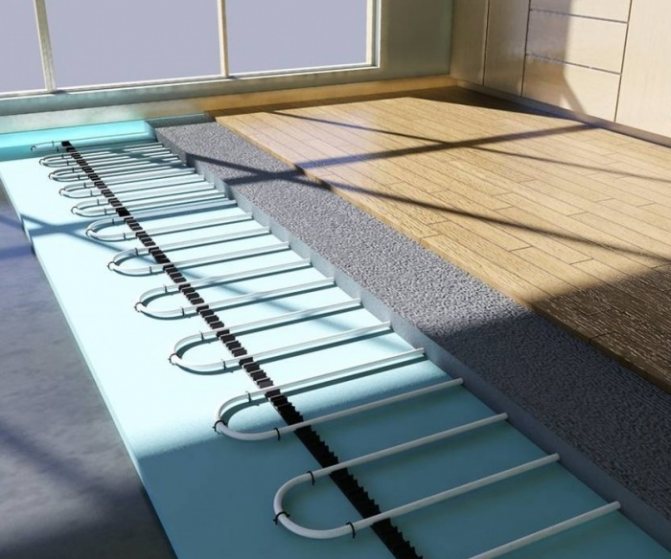

However, water heating elements also have their drawbacks. You should also learn more about them:
- temperature control is much easier than infrared or electric floors;
- in the process of laying plastic pipes, the floor level rises by 10 cm;
- when laying a water floor, it is impossible to completely eliminate leaks;
Due to the disadvantages that a water floor has, it should not be installed in apartments in multi-storey buildings. If a leak occurs, several problems arise - the coating material will warp and the wiring will short out.
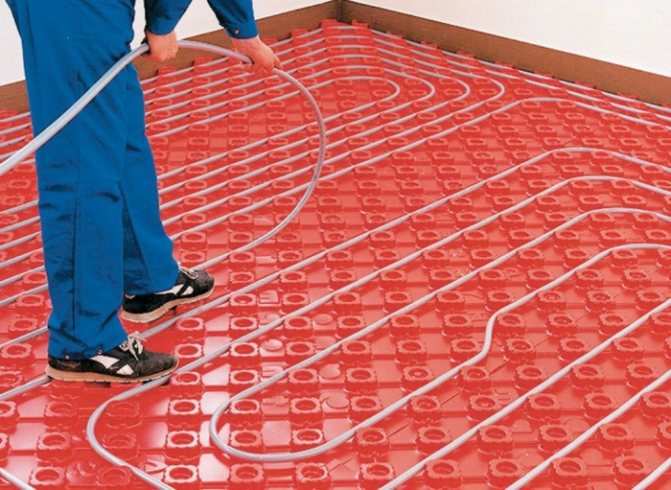

Water heating circuit
Owners of private houses have the possibility of arranging a water heated floor, when a closed circuit is arranged inside the screed or on top of it, which heats up from the coolant circulating through the pipes. The laid underfloor heating system is connected to a heating boiler or central water supply system.
The advantage of water floor heating is:
- Uniform heating.
- Complete environmental friendliness and safety.
- Minimum power consumption.
The disadvantages of this technology are the impossibility of adjusting the floor heating temperature, as well as possible leaks of the coolant, which leads to the need to disassemble the laid floor covering. That is why the quality of the materials used and the correct installation must be given due attention.
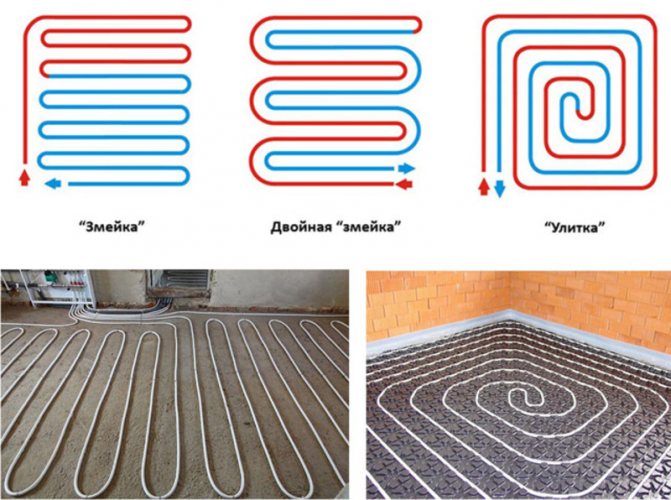

Underfloor heating is a system that uses hot water as a heat source.
The system of pipes for a warm water floor is mounted on top of the screed, and the used parquet board is placed on a special insulation and a system of wooden logs. The latter are necessary to prevent damage to the pipeline during the operation of the floor. All installation work is best entrusted to a specialist who can not only carry out this work correctly, but also competently plan the connection of the heating circuit to an autonomous gas or solid fuel boiler. This will ensure trouble-free operation and performance of the entire heating system.
Arrangement of underfloor heating will completely solve the problems with heat in the room. The homeowner will only need to decide which warm floor is better for the parquet board, choose the right heating mats and floor material to use. If it is not difficult to lay electric infrared mats on your own, then when arranging a water system, it is best to entrust this work to professionals.
Underfloor heating systems
To figure out how compatible a warm floor and a parquet board are, you should take a closer look at their design and operational features.
Floor heating attracts, first of all, by the possibility of uniform heating of the room. Unlike classic wall-mounted heating radiators, underfloor heating creates the most comfortable temperature in the lower half of the room, that is, in the area where the residents are usually located.
In the case of wall-mounted radiators, the air heated by them first rises to the ceiling, and only then begins to spread to the bottom. In this regard, the efficiency of floor heating systems is much higher.
Today, there are three main types of underfloor heating on sale:
Each of these systems has its own characteristics, advantages and disadvantages.
Water floors
In this case, a heated coolant serves as a heat source. The entire heating structure consists of a hot water boiler, from which the coolant is supplied by circulating sediment to a system of pipes laid under the floor covering.
Most often, flexible plastic acts as a material for pipes. Such pipes, unlike metal ones, are easily deformed under external influence, which can create obstacles for the normal circulation of the coolant.
Therefore, after installation, the water floors are filled with a cement screed, which plays not only the role of protection from external physical influences, but also a heat conductor.
Cable and infrared foil floors
This type of underfloor heating uses electricity as a source of thermal energy. True, there are significant differences in their design and operation.
Cable floors are electrical wires enclosed in an insulating sheath and which, under the influence of current, begin to heat up. From them, heat is transferred to the surrounding objects, primarily the floor covering.
Cable floors, for the same reasons as water floors, are poured into a concrete screed, which serves as "armor" and increases the efficiency of the heating system.
Film floors are also powered by electricity, but infrared radiation is used to transfer heat. Special graphite heating elements enclosed in a protective film convert electricity into infrared radiation. By means of infrared rays, the heat from the foil floors is transferred to the surrounding surfaces.
Due to this feature of operation, infrared floors are not enclosed in a concrete screed. In this case, it can only be used as a leveling base.
As you can see, all floor heating systems, regardless of their design features, have one main thing in common: the floor covering is initially heated, from which thermal energy is transferred to the surrounding air.
In this context, it is necessary to disassemble the compatibility of parquet and underfloor heating.
Floor heating technology
Electric underfloor heating technology is based on the property of special semiconductor cables to emit heat when electricity is passed through a wire. Accordingly, by applying voltage to the heating cable laid under the floor covering, it is possible to efficiently heat the room, while significantly reducing utility bills.
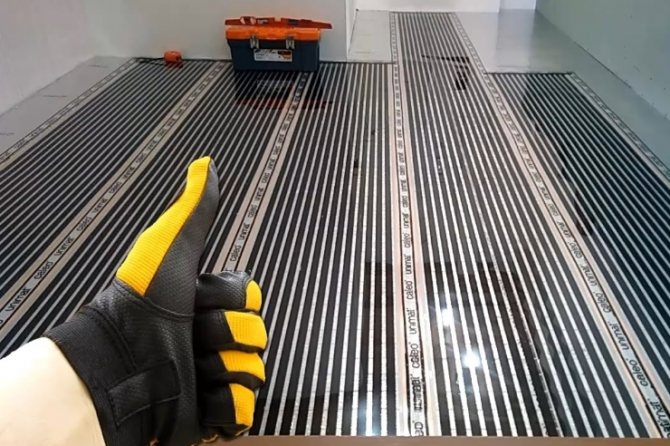

Film warm floor perfectly heats the parquet board
Today, several technologies are used for underfloor heating, including the use of a classic heating cable, infrared film and electric heating with fully automatic control. Using modern heating methods allows you to easily ensure the optimal temperature in the roomthus reducing energy consumption.
The warm film floor works in a completely autonomous mode, and the control unit receives all the necessary information from various sensors, based on the data from which the heating intensity decreases or increases.
When planning to lay the heating system, it must be remembered that the thickness of the wooden dies should not exceed 12 millimeters, since in the presence of thicker floor material, the heating efficiency will be minimal. Subject to the correct selection of all components and proper installation in the future, such a heating system will not cause any trouble, functioning properly for many years.
What kind of warm floor to choose for parquet and parquet board
Water heating
This system is a network of polymer pipes through which hot water circulates from a boiler or central water supply system. A screed is poured on top, on top of which the finishing coating is laid. It is a contact heating system, i.e. the coolant, passing along the heating circuit, gives off its heat to the screed, which in turn heats the floor covering. This system is rather complicated and expensive to install. In the event of a failure, locating and rectifying the failure is not an easy task. The use of such a system in apartment buildings is prohibited (clause 11.9 of the Decree of the Moscow Government No. 508-PP of 10/25/2011).
Types of heating systems
There are several combinations that are possible when installing a parquet board on a warm floor. For example, you can choose the following types of heating systems:
- Electrical. From the point of view of economy, underfloor heating with electricity is very beneficial. Floor heating comes from heat cables. They transfer heat energy to the parquet. The coating should not be heated to a temperature of 26 degrees.
- Infrared. These systems include graphite rods soldered into a polymer film. Heat radiation is carried out in the infrared range. As a result, it is not the air that heats up, but the parquet board itself and the objects in the room.
- Water. Such heaters have plastic pipes in their design, through which heated water flows. With this design, the floors are warmed up more evenly. In addition, if the system fails, fire is excluded.
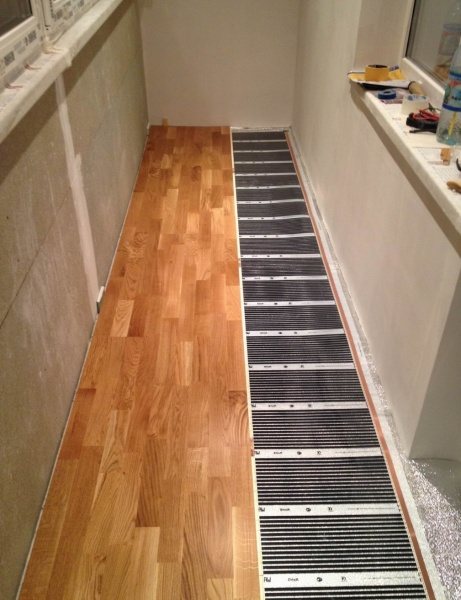

Such features of warm floors indicate the safety of laying under a parquet board.
Why wood flooring is not suitable for heated floors
There is no worse coverage for warm floors than natural wood. Whichever side you look at, this solution has some drawbacks. Let's look at the problem from two points of view: heating and decoration.
Heating problem
The whole structure of a warm floor in a room: pipes with a coolant circulating through them, a concrete screed or a rack or floor system that replaces it and a covering - this is one large heating device
It is important for the heater that the maximum possible part of the thermal energy enters the room without encountering obstacles in its path. The cast-iron battery transfers heat to the environment without any problems
Also, the warm floor, where the pipes are filled with a layer of concrete about 4 cm thick, and ceramic tiles are laid on top, gives off heat energy well to the room. This is because metal, concrete and ceramics have high thermal conductivity.
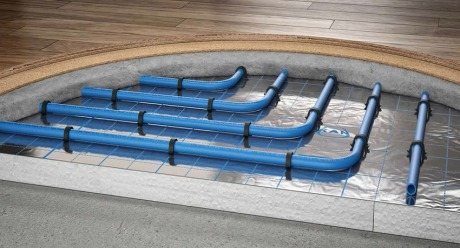

An experiment can be carried out: in winter, wrap the radiator located in the room under the window in a warm blanket. After a while, we will feel that the room has become noticeably colder. The blanket prevents heat transfer, the coolant returns to the system at almost the same temperature that entered the battery. If we wrap all the radiators in the house in blankets, the rooms will become cold, and the boiler may overheat.
Natural wood has low heat transfer and works like a blanket, reducing heating efficiency. In addition, thermal energy, meeting an obstacle to its distribution from above, will tend downward, into the ceiling or sub-base of the floor. In order not to lose a significant part of the heat, you will have to additionally insulate the floor structure from below. And this is financial costs and a decrease in the height of the room due to an increase in the thickness of the insulation. The above indicates that it is not economically feasible to use a natural wood covering for underfloor heating.
Coating problem
Natural wood is a "living" finishing material. Wood fibers easily pick up and release moisture, while the geometric dimensions of the products change noticeably. Wet wood swells, when moisture is lost, it shrinks, the changes are especially large across the fibers. The relative humidity in the room in summer is 40-65%, at these values, wooden furniture and floors "feel" well. During the heating season, with radiator heating and the absence of humidifiers, humidity can drop to 20-35% and below. At the same time, the wooden floors dry up: gaps appear between the parquet floors and the closer to the batteries, the wider the gaps in the floor. Imagine that the entire floor is a large radiator that constantly heats the entire surface of the wooden floor. Under the influence of heat, the wood will dry out, the parquet floors or boards will decrease in size and noticeable gaps will appear between them throughout the entire area of the coating. The higher the temperature of the heated floor, the more the wood will dry out during the winter.
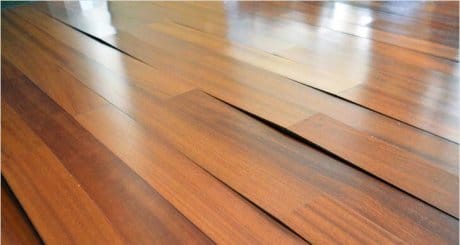

A multilayer parquet board will behave a little more stably. Due to the fact that it consists of several layers of wood, the fibers of which are located perpendicularly, the moisture-temperature deformations of the glued parquet board are not as great as those of massive parquet and floorboard.
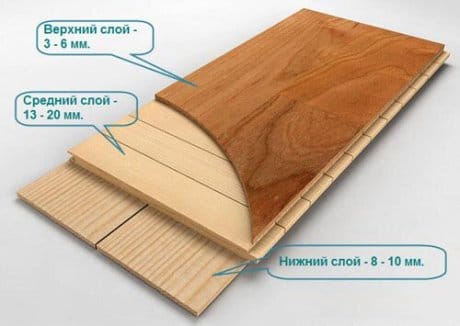

But here the consumer faces a different danger. In the manufacture of parquet boards, glue containing formaldehyde is used. Up to a temperature of 26 ºC, it is bonded in glue and the parquet board is safe. When the specified temperature is exceeded, harmful formaldehyde vapors begin to be released and enter the air. At the same time, the operating temperature of the coolant in the heated water floor system, which is provided by standard equipment, is 40ºC. The floor surface can be heated up to 35 ºC.
Expert opinions on the proximity of parquet and underfloor heating
Experts in the field of construction and repair disagreed: some are categorically against the union of warm floors with parquet, others do not see anything wrong with this. We will listen to the arguments of both those and others.
Why not"?
Firstly, wood has a low coefficient of thermal conductivity, that is, it cannot pass heat through itself.Parquet, laid on a "warm floor", simply will not heat up, or the heating process will be extremely slow. Thus, the efficiency of the heating system will decrease to 0, and then a reasonable question arises: "Why do we need such a heating structure at all?" Parquet, laid in accordance with all the rules and standards, in itself is already an excellent heat-saving element of a house or apartment.
Secondly, under the influence of heat, wooden planks will begin to dry out over time, cracks will appear and your parquet will begin to "sing songs", as if it has already turned 100 years old. An endless creak, complemented by twisted planks with cracked varnish - this is what awaits you in a year or two. Are these problems worth the money spent on installing a warm floor if you have to constantly putty, touch up, loop and repair the parquet? Probably not!
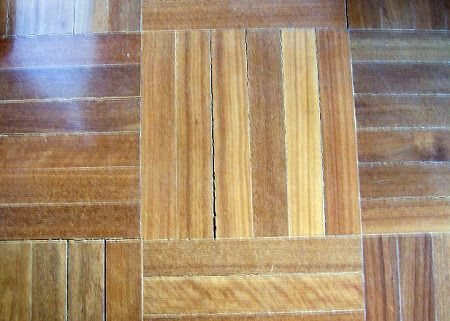

This is how the parquet will look like a year after laying it on a warm floor.
Thirdly, you will have difficulties when laying parquet on a warm floor. Look. The correct base for parquet is plywood. By all building standards, plywood must be glued to the screed (so that it does not "walk") with a special adhesive, and for greater reliability (you never know) it is also screwed on with self-tapping screws. A small sheet of plywood (50x50) is fixed in at least 8 places, respectively, the larger the sheet, the more screws you will need to use. Now a question? Is it possible to tighten the self-tapping screws so as not to touch the power cable (if you are using an electrical heating system) or tubes (if you have chosen a water system)? It is possible to indicate the location of the elements of the warm floor only approximately, but it is not worth working "by eye".
Why yes"?
Other experts are sure that the problem is too inflated and that parquet may well coexist with a warm floor if it is properly laid.
They propose to use two-component polyurethane glue for reliable fixing of plywood, which does not require additional fastening with self-tapping screws. But will this glue keep the floor from drying out? Most probably not! However, here too the experts found a way out. The heat-insulating material, laid under the plywood, will save the parquet from premature aging. And here again the question arises: "Why arrange a warm parquet floor if its heat will still be insulated?" No answer…
What is a parquet board
Parquet board is a relatively new type of flooring used as an alternative to parquet.
This type of board has a number of the following advantages:
- environmental friendliness, the composition includes natural wood;
- convenience during installation / dismantling, the board is sold already processed and no additional preparation of the material is required before installation, which saves time spent on installation, and a convenient lock connection simplifies the laying technology;
- if necessary, the flooring of parquet boards can be easily dismantled without damaging the material itself; after dismantling, the parquet board can be reused;
- the possibility of operation immediately after installation, after the flooring of parquet boards has been installed, it can be used immediately because it does not require additional work - coating with oil, varnish, etc .;
- price, the relatively low price can be attributed to the advantages of this material;
- presentable appearance, thanks to the presentable appearance, the parquet board will look favorably in any room;
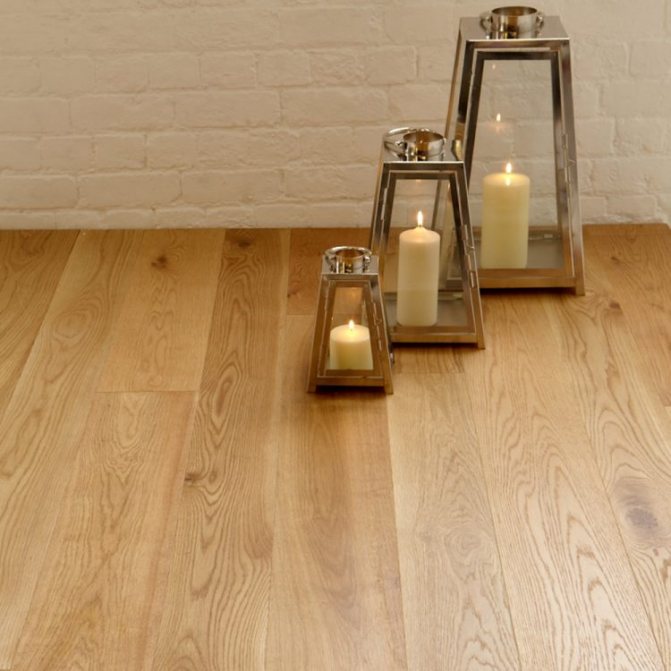

But in addition to the advantages, this material also has disadvantages, which are important to consider:
reduced moisture resistance, this material does not differ in moisture resistance - therefore, when carrying out installation work, special attention must be paid to protection from moisture; a claim for stratification of the material, during improper operation or installation there is a risk of stratification of the material, which, of course, will negatively affect the appearance of the coating and the room as a whole; increased requirements for the base surface, a prerequisite for laying parquet boards is a perfectly flat surface.
Underfloor heating under a solid board has a number of truly unique properties, such as
- Durability
- Resistant to cycling
- Excellent heat and sound insulation
- Great appearance
- No complexity in installation and operation
Massive wide boards made of solid wood, have a tenon-groove profile in their cross-section. This common type of flooring is very reliable and durable. Each floorboard has a tongue-and-groove system on the four sides. Thanks to this system, installation is much easier, but, despite this, the installation of massive floorboards remains a laborious process that requires the involvement of professionals. High noise insulation and low thermal conductivity leave noise outside, warm air inside.
But, at the same time, the floor board has not only advantages, for example:
- Needs regular maintenance (periodically, the floor needs to be covered with a protective varnish, and this is the cost of painting and the smell of varnish, within one to three days)
- Wood, like any of natural materials, has the property of "breathing", i.e. narrows in winter, expands in summer. As a result of these processes, over time, distances appear between the boards.
- It is recommended to eliminate this defect near the floor with puttying, but everything can happen again after a certain period of time.
- The relatively high price of a wooden floor. After all, the cost of a bar for laying the floor, the board itself, as well as work on installing the floor and caring for it, to put it mildly, is not cheap.
But, looking at the result, you understand that it was all worth it.
Output.
If you like environmentally friendly materials and what a natural structure looks like, then you undoubtedly need a board for a warm floor, period!
With just one effort, time and money, installing a wooden floor, you will be very satisfied for a long period of time.
Primary requirements
If it was decided to lay a wooden covering on a warm floor, then, in order to avoid possible problems, the following number of features of such a combination should be taken into account:
- The most suitable type of parquet for laying on a warm floor is parquet board, since this floor covering is better than others capable of withstanding changes in humidity and temperature.
- In order for the board not to dry out too much when heated, its factory humidity should not be higher than 6..7%.
- It is best to choose a board with the smallest possible plank width, because the size of the slot, all other things being equal, is directly proportional to the transverse dimension of the plank.
- Parquet boards on a warm water floor should be installed either by professionals, or at least under their direct control.
- The maximum permissible temperature of the parquet surface is 26 ° C, and it is strictly not recommended to exceed it. Any excess can cause drying and deformation of the planks of the parquet board.
- Any change in floor temperature during operation should be gradual.
- When using a warm water floor system, a waterproofing layer should be installed.
- When choosing a parquet board, you should focus on the one that is made from deformation-resistant wood. The most commonly used wood is oak. At the same time, maple or beech wood is the most undesirable choice, since it is these species that are most sensitive to changes in moisture levels.
- In order to prevent the humidity level from falling below 40%, a humidifier should be used.
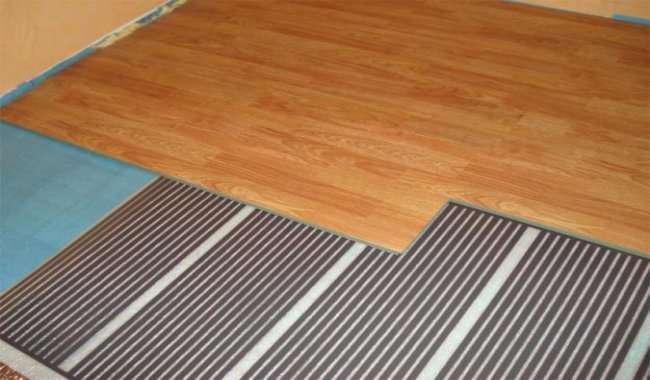

laying parquet boards on a warm floor
Arrangement of film heating
When arranging heating, it is necessary to remember about the property of wood to deform under the influence of heat and significant temperature changes. Therefore, it is not recommended to equip a warm floor under a board, which is made of beech or maple. Walnut and oak are the best materials for making heated parquet flooring.The wood of these species does not shrink or expand under the influence of high temperatures, which provides optimal heating, guaranteeing the durability of the renovation carried out in the house.
When arranging heating for a board, the following should be considered:
- The type of heating elements used. Wood is a flammable material, therefore an extremely safe and reliable heating system should be used.
- Laying method. To prevent subsequent deformation of wooden floor materials, they should be laid with a so-called floating joint.
- Board thickness. The thicker the material, the lower the heating efficiency. Heating can be performed if the thickness of the parquet strips does not exceed 12 millimeters.
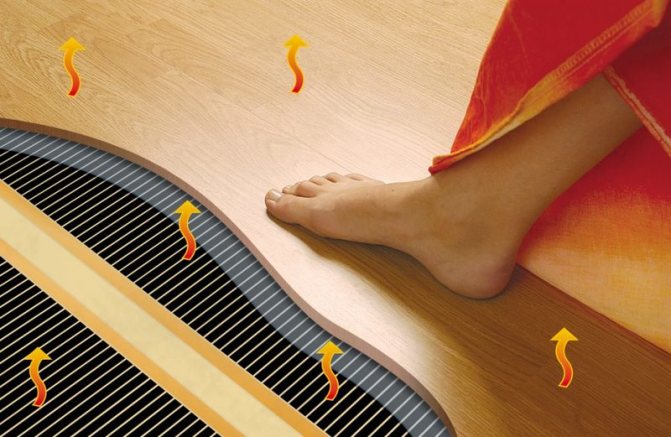

The best material for the manufacture of heated parquet - walnut and oak
Today, you can find various heating cables and infrared mats on sale, the use of which can significantly simplify the arrangement of high-quality electric heating under a wooden floor. The easiest way is to use infrared mats, which are laid over the entire surface of the floor, connected with a cable, after which the control equipment is connected to them, and voltage is applied.
After fixing the heating mats on the floor surface, a test run should be carried out, for which the operability of the entire system is checked. Next, a special substrate is laid on top under the board, which must be made of non-combustible materials and, at the same time, have good thermal conductivity.
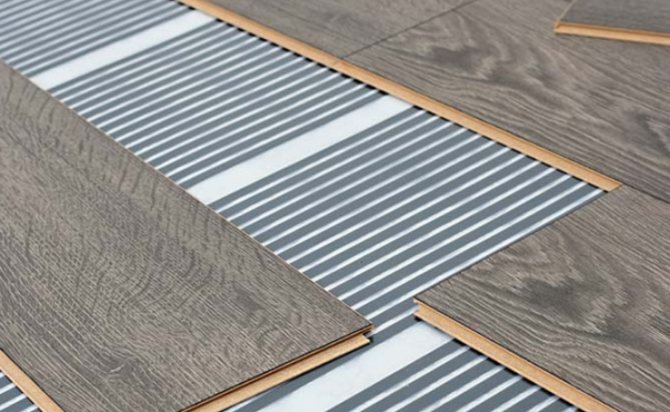

The principle of operation of infrared film is based on the conversion of electrical energy into infrared radiation.
A floorboard is laid on top of the substrate using floating joints, the baseboards are installed and the heating operation is checked again. The heating control unit should be brought out and, if possible, connected to the general automation system “Smart Home”. All the homeowner needs to do is set up the automation to heat the room, taking into account the required temperature in the house.
Installation work using high-quality infrared mats and electric cables is not particularly difficult, therefore, even having initial skills in working with floor coverings, you can independently lay the parquet board on the warm floor... It is only necessary to correctly calculate the required number of heating mats, temperature sensors and other control electronics, which will make it possible to equip a reliable and stable heating system.
Choosing a warm floor for a parquet board
Without going into particular details related to the organization of heating using electric cables or pipes with hot water as a heat carrier, we only note that both options have found application in repair and construction and design solutions.
At the same time, the organization of electric heating is cheaper in terms of work and materials, while water heating can use different types of fuel and is cheaper in operation.
Electric heating is more often used to solve local problems in individual rooms, and hot water is mainly used to heat houses with their own heating system or to heat large objects.
As a rule, underfloor heating systems are used to heat cold floor coverings: tiles, porcelain stoneware, laminate, linoleum. However, if you decide to use parquet or solid oak flooring, check out the following guidelines. As you know, wood does not have thermal conductivity and, by laying parquet or plank on a warm floor, you reduce the efficiency of the heating system.
As a possible option - installation of plywood on two-component polyurethane glue. When using it, you can do without self-tapping screws. But this will not prevent your parquet from drying out.If you nevertheless decide to lay parquet or solid plank on heated floors, then it is desirable that the wood flooring at the time of installation has a moisture content of 8 + _2%. It is recommended to use the most stable wood species with a close to radial cut.
It is advisable to use oil as a topcoat on heated floors. It does not break the coating layer when the dies move, has a higher permissible operating temperature on heated floors. The oil has a wide range of colors for tinting floors, provides the possibility of local repair and faster, compared to varnish, complete renewal of the top layer.
If the finishing of parquet or decking is carried out under production conditions, the use of oil is less laborious and requires less time. The use of parquet with bevels and a factory-applied oil coating will allow, avoiding grinding and applying oil on the object, to reduce the time for work. In this case, it becomes possible to apply oil to the end sides of the laying elements, which provides increased moisture protection of the parquet during operation, including in the presence of gaps between the planks.
The lower wear resistance of oil coatings will require more painstaking and frequent maintenance and reapplication, which, at the same time, is not a particularly difficult and expensive factor.
Types of parquet and laying on a warm floor
It is possible to lay a massive board on a warm floor, but it is difficult. The solid board is mounted on plywood. Plywood needs to be shot with dowels to the screed and this is where the problems begin. You cannot know the exact location of the underfloor heating installation, so traditional fastening of plywood to dowels is unacceptable. If plywood is glued onto two-component glue in large pieces, it will not be possible to grind it, because the glue will remain elastic. You can glue the plywood on one-component glue - so that warping does not start, the plywood pieces should be no more than 5 × 5 cm in size and each piece should be fixed with a load.
Warm floor under parquet and parquet board
Parquet is a floor covering with a thickness of 15 to 22 mm, made entirely of natural wood. Parquet is not a finished product, therefore it is sanded and varnished after installation. With careful use, the average service life of block parquet is more than 50 years.
Parquet board is a wooden floor covering made by gluing several layers of wooden planks. The bottom layer is stabilizing, made of softwood. The middle bearing layer is also made of softwood. The top layer is decorative, made of valuable wood. From above, the parquet board is protected with varnish or impregnated with oil. The total thickness of the parquet board is 14 mm, while the thickness of the top layer does not exceed 4 mm. The average service life of a parquet board, subject to the rules of operation and renewal of the varnish coating every 4-5 years, is 15-20 years.
Recommendations for work
Since the cost of materials is high, as are the costs of a floor heating device, it is important to do everything right and choose the optimal materials. ... Types of heating systems
Types of heating systems
To begin with, let's figure out which warm floor is better for a parquet board, there are three main options on the market, we will tell you more about each of them:
- Electrical systems are distinguished by such factors as low price and a fairly simple installation process (although there are certain nuances). But they have one property, which is a big disadvantage when using a board - the heating rate is too high, and as you know, sudden temperature changes cause cracks on the surface, which is why this solution is the least preferable;
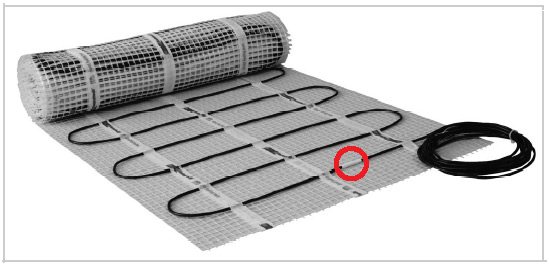

Electric underfloor heating is not suitable for our case
- Infrared systems are distinguished by the fact that they do not heat the air, but all the surrounding objects, their advantage is simple installation instructions, it is as easy as shelling pears to carry it out with your own hands - you need to spread the sheets and connect power to them, the board can be laid directly on the surface. This solution is also well suited in our case, since the nature of its work assumes a less aggressive effect on the material;
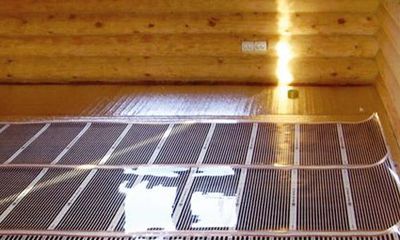

This option is good because the board can be put directly on the film.
- Water systems are the most difficult to install, but their properties and performance are much better than other options. That is why a parquet board is best suited for a warm water floor, the main reason is that it heats up very slowly, which provides a minimal negative effect on the material, and during operation, a constant temperature is most often maintained.
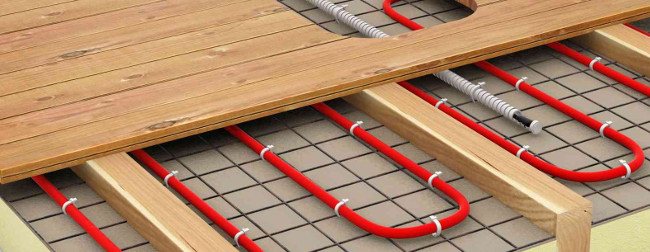

A water heat-insulated floor under a wooden plank also fits very well
Possible options
To create an effective system of additional or main heating, you need to choose the type of underfloor heating that is most suitable for your case. There are several types of such heating:
- Water systems based on the circulation of a heated liquid through pipes laid under the floor covering. Sometimes a concrete screed is poured for this, and sometimes a "dry" method of pipe installation is used.
- Electric heating cable. It can also fit into a screed or other type of rigid base.
- Infrared heating system. These are the so-called "film" floors. They are efficient and have a minimum thickness, and are also very easy to install - there is no need to fill the screed.
If you plan to lay the parquet board directly on the parquet composition, then the choice is unambiguous - a film system. If it is possible to fill the screed, then you can choose one of two options - water pipes or heating cable.
Requirements for planning and installation
To ensure the full functionality of the warm floor and the preservation of the aesthetic and physical properties of the parquet, it is important not only to choose the type of energy carrier correctly. Here it is worth adhering to a number of rules:
- it is better to avoid parquet boards made of beech, maple - these types of wood are extremely sensitive to temperature extremes, in such conditions they quickly deform;
- the optimum thickness of the floor covering is 12-15 mm. The use of thin dies is fraught with their destruction due to frequent heating; thick panels will prevent the penetration of thermal energy into the room;
- the floating method of laying the floor will allow the structural elements to move evenly under the influence of heat, so rapid warping and destruction of the wood can be prevented;
- the arrangement of the plywood substrate becomes a mandatory measure, it is fixed on a concrete base with two-component polyurethane glue. In addition, self-tapping screws can be used, they are introduced according to the preliminary marking;
- a thin insulating layer can be placed directly under the parquet to protect the wood from high temperatures. But this measure can become an obstacle to the spread of thermal energy;
- when installing wooden panels, it is recommended to use metal brackets, in this case the floor covering is assembled without additional fixation to the base. Conditions are formed for a natural change in the dimensions of the dies due to a change in their temperature.
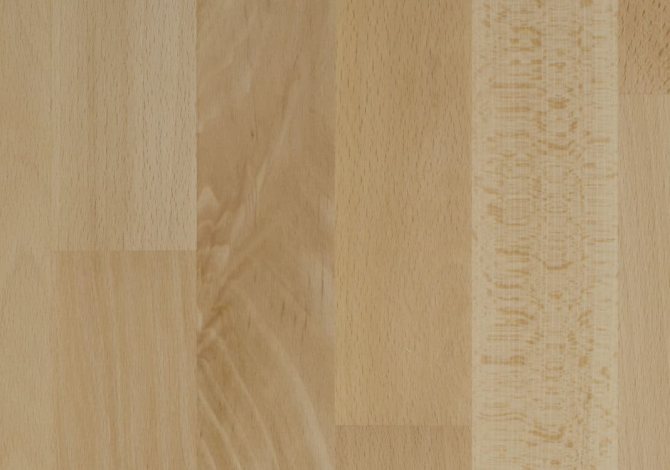

Do not use beech parquet boards
The maximum permissible heating level for the bottom layer of the wooden floor covering is + 40 ° C. In this case, + 27 ° C will be felt on the surface. Moreover, the heating system must be designed in such a way as to ensure uniform heating of the entire area.
Installation technology under parquet
The easiest installation options are electrical and infrared systems - they operate on the network, do not require piping, and can be installed under surfaces with a difference in height.
Infrared floor
Film products are attracted by the ease of installation, all work can be done in a short time. The first step is to prepare the base with mandatory thermal insulation measures. The base for the heating elements must be clean and dry - this is a guarantee of a long service life and the safety of the warm floor.
It is necessary to completely remove the remnants of the old floor covering, after dismantling the wooden or concrete floor base should be exposed. Using a level, it is necessary to check the uniformity of the surface height, and if the slope was not originally conceived, the differences should be no more than 3 mm. Next, the base is polished (if it is concrete) or they organize scraping (if the house has a wooden floor covering). The resulting debris is removed without residue, the base must be thoroughly cleaned: a household or industrial vacuum cleaner will come in handy here. Lay a waterproofing polyethylene film, on top - a heat-insulating material.
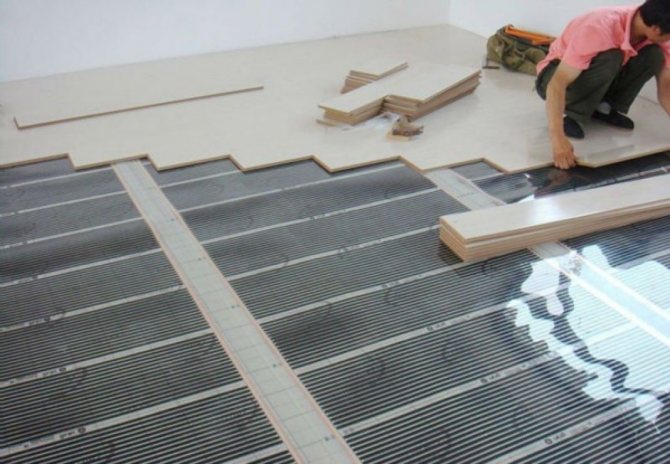

Infrared underfloor heating under parquet
The site is subjected to marking, during which they also determine the place of insertion of the temperature sensor, the installation zone of the temperature controller, and the way of connecting the device to the network. An infrared film is laid along the room in strips downward, fixed with construction tape. Bituminous insulation protects silver-plated contacts and cut lines crossing the conductors.
After placing all the heating elements, a plywood substrate is installed (it is advisable to carefully fix it with self-tapping screws), a parquet board is collected on this base.
Electric floor
This is the more common cable-based option. It is important to adhere to the installation techniques recommended by the manufacturer in order to minimize the fire hazard of the solution.
Here you also need to prepare the base in advance: dismantle the old coating, clean the surface, remove debris, level it using putty mixtures. When the site is completely dry, a layer of waterproofing material is applied and left for the time required for high-quality setting of the substance.
Next, a frame is built: support lags are installed with a step of at least 60 cm.In the resulting cells, a heat-insulating material is placed, for example, mineral wool or penofol. Strips of waterproofing are laid on top, they need to be fixed with an overlap, connecting with glue. The next layer is galvanized mesh.
The electric cable is placed at a distance of 1 cm from the log, cuts are made in the bars, through which the cable and foil are passed, mounting tape is used to fix it. A second layer of heat-insulating materials is performed on top, a plywood substrate is formed, on which a final parquet floor is further equipped.
Arguments against"
Opponents of using this type of finish in conjunction with underfloor heating systems cite the characteristics of the boards as the main argument: very low thermal conductivity and, as a consequence, the inability to normally warm up the layer of wood. Therefore, it is pointless to lay a warm floor under a parquet plank - the efficiency of the structure will be practically zero.
In addition, when heated, the wood will expand and deform, which will inevitably lead to all sorts of problems: the appearance of cracks, the creak of the dice, and so on. There will be a need to constantly monitor the condition of the coating and permanently correct the emerging defects. At the same time, wood itself is already an excellent heat-saving material that does not need additional heating.
The last compelling argument will be the need to use plywood as a base for laying parquet.It will have to be fixed to the floor with self-tapping screws, and at the same time, there is a risk of damaging the heating circuit, even if the parquet board for a warm water or electric floor is mounted on top of a concrete screed - it is into it that the screws fixing the plywood base will be screwed.
Arguments for"
Some manufacturers of flooring such as parquet board claim that it can be used with a solution such as a warm water or electric floor. They believe that the main condition for the effective operation of the system is the uniformity of heating and the rejection of certain types of wood that do not tolerate heat too well - beech and maple. Otherwise, manufacturers do not see any obstacles to the joint use of a wooden surface and this type of heating.
In this case, under this type of coating it is better to lay exactly a water, and not an electric warm floor. It will give a more uniform heating of the surface and prevent the premature appearance of various cracks, drying of the planks, and so on. An important condition for the long service life of wooden planks will be control over the heating temperature - it should not exceed 26 degrees.
The heating cable does not provide a table with uniform heating and the only argument in its defense will be the ability to accurately regulate the heating temperature using a thermostat. However, temperature drops, which are undesirable, cannot be avoided here - when the heating is turned off, the liquid systems cool down slowly, while the electric cable becomes very cold very sharply. Such temperature jumps will adversely affect the condition of the coating.
An ideal solution can be a film warm floor, which can be laid under parquet without any fear. The principle of space heating in this case is completely different and is based on the transfer of radiant energy, rather than direct heating of the surface. Infrared radiation will not damage the wood in any way and will not change its basic characteristics. At the same time, the heating efficiency will be high.

